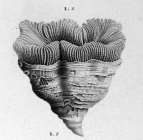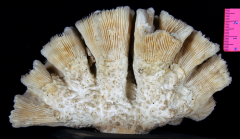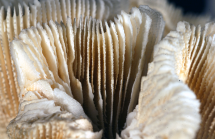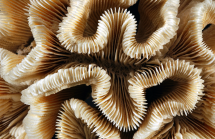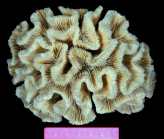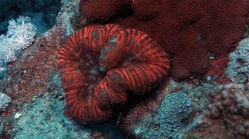WoRMS taxon details
Trachyphyllia Milne Edwards & Haime, 1849
204973 (urn:lsid:marinespecies.org:taxname:204973)
accepted
Genus
Manicina amarantum Dana, 1846 accepted as Trachyphyllia geoffroyi (Audouin, 1826) (type by original designation)
Callogyra Verrill, 1901 · unaccepted > junior subjective synonym
Wellsophyllia Pichon, 1980 · unaccepted > junior subjective synonym
- Species Trachyphyllia geoffroyi (Audouin, 1826)
- Species Trachyphyllia amarantum (Dana, 1846) accepted as Trachyphyllia geoffroyi (Audouin, 1826) (unaccepted > junior subjective synonym)
- Species Trachyphyllia amarantus (Müller, 1775) accepted as Trachyphyllia geoffroyi (Audouin, 1826) (unaccepted > junior subjective synonym)
- Species Trachyphyllia lelandi Nemenzo, 1971 accepted as Trachyphyllia geoffroyi (Audouin, 1826) (unaccepted > junior subjective synonym)
- Species Trachyphyllia pentagona (Esper, 1790) accepted as Favites pentagona (Esper, 1790) (unaccepted > superseded combination)
- Species Trachyphyllia radiata (Pichon, 1980) accepted as Trachyphyllia geoffroyi (Audouin, 1826) (unaccepted > junior subjective synonym)
- Species Trachyphyllia stricta (Dana, 1846) accepted as Trachyphyllia geoffroyi (Audouin, 1826) (unaccepted > junior subjective synonym)
marine, fresh, terrestrial
Milne Edwards H, Haime J. (1849). Recherches sur les polypiers. Quatrième mémoire. Monographie des astréides(1). Tribu II. Astréens (Astreinae). <em>Annales des Sciences Naturelles, Série 3, Zoologie.</em> 11: 233–312. [details]
Description 'Diffère surtout du précédent [Colpophyllia] en ce que les séries restent libres par les côtés, que la columelle est...
Description 'Diffère surtout du précédent [Colpophyllia] en ce que les séries restent libres par les côtés, que la columelle est spongieuse et bien marquée et que les cloisons présentent un lobe paliforme bien distinct.' (Milne Edwards and Haime, 1848, vol. 27: 492) [details]
Hoeksema, B. W.; Cairns, S. (2024). World List of Scleractinia. Trachyphyllia Milne Edwards & Haime, 1849. Accessed through: World Register of Marine Species at: https://www.marinespecies.org/aphia.php?p=taxdetails&id=204973 on 2024-04-19
Date
action
by
![]() The webpage text is licensed under a Creative Commons Attribution 4.0 License
The webpage text is licensed under a Creative Commons Attribution 4.0 License
original description
Milne Edwards H, Haime J. (1849). Recherches sur les polypiers. Quatrième mémoire. Monographie des astréides(1). Tribu II. Astréens (Astreinae). <em>Annales des Sciences Naturelles, Série 3, Zoologie.</em> 11: 233–312. [details]
original description (of Wellsophyllia Pichon, 1980) Pichon, M. (1980). <i>Wellsophyllia radiata</i> n. gen., n. sp., a new hermatypic coral from the Indonesian region Cnidaria, Anthozoa, Scleractinia). <em>Revue Suisse de Zoologie.</em> 87: 253-259. [details] Available for editors [request]
[request]
original description (of Callogyra Verrill, 1901) Verrill AE. (1901). Variations and nomenclature of Bermudian, West Indian and Brazilian reef corals, with notes on various Indo-Pacific corals. <em>Transactions of the Connecticut Academy of Arts and Sciences.</em> 11: 63-168. [details]
basis of record Veron JEN. (1986). Corals of Australia and the Indo-Pacific. <em>Angus & Robertson Publishers.</em> [details]
additional source Veron JEN, Pichon M, Wijsman-Best M. (1977). Scleractinia of Eastern Australia – Part II. Families Faviidae, Trachyphylliidae. <em>Australian Institute of Marine Science Monograph series.</em> 3: 1-233. [details]
additional source Veron JEN. (2000). Corals of the World. Vol. 1–3. <em>Australian Institute of Marine Science and CRR, Queensland, Australia.</em> [details]
additional source Budd AF, Fukami H, Smith ND, Knowlton N. (2012). Taxonomic classification of the reef coral family Mussidae (Cnidaria: Anthozoa: Scleractinia). <em>Zoological Journal of the Linnean Society.</em> 166 (3): 465-529., available online at https://doi.org/10.1111/j.1096-3642.2012.00855.x [details]
additional source Matthai G. (1928). A Monograph of the Recent meandroid Astraeidae. <em>Catalogue of the Madreporarian Corals in the British Museum (Natural History).</em> 7: 1-288, pls. 1-72. [details] Available for editors [request]
[request]
additional source Best MB, Hoeksema BW (1987) New observations on scleractinian corals from Indonesia: 1. Free-living species belonging to the Faviina. Zoologische Mededelingen, Leiden 61: 387-403. [details]
additional source Huang D, Benzoni F, Fukami H, Knowlton N, Smith ND, Budd AF (2014) Taxonomic classification of the reef coral families Merulinidae, Montastraeidae, and Diploastraeidae (Cnidaria: Anthozoa: Scleractinia). Zoological Journal of the Linnean Society 171: 277–355. [details]
additional source Duncan PM (1884) A revision of the families and genera of the sclerodermic Zoantharia, Ed. & H., or Madreporaria (M. Rugosa excepted). Journal of the Linnean Society of London, 18: 1-204. [details]
additional source Moseley, H. N. (1881). Report on certain hydroid, alcyonarian, and madreporarian corals procured during the voyage of H.M.S. Challenger during the years 1873-76. Part III. On the deep-sea Madreporaria. Report on the Scientific Results of the Voyage of the H.M.S. Challenger during the years 1873-76 (Zoology), 2, Zoology, 3, (1): 127-208, 238-248
page(s): 182 [details]
original description (of Wellsophyllia Pichon, 1980) Pichon, M. (1980). <i>Wellsophyllia radiata</i> n. gen., n. sp., a new hermatypic coral from the Indonesian region Cnidaria, Anthozoa, Scleractinia). <em>Revue Suisse de Zoologie.</em> 87: 253-259. [details] Available for editors
original description (of Callogyra Verrill, 1901) Verrill AE. (1901). Variations and nomenclature of Bermudian, West Indian and Brazilian reef corals, with notes on various Indo-Pacific corals. <em>Transactions of the Connecticut Academy of Arts and Sciences.</em> 11: 63-168. [details]
basis of record Veron JEN. (1986). Corals of Australia and the Indo-Pacific. <em>Angus & Robertson Publishers.</em> [details]
additional source Veron JEN, Pichon M, Wijsman-Best M. (1977). Scleractinia of Eastern Australia – Part II. Families Faviidae, Trachyphylliidae. <em>Australian Institute of Marine Science Monograph series.</em> 3: 1-233. [details]
additional source Veron JEN. (2000). Corals of the World. Vol. 1–3. <em>Australian Institute of Marine Science and CRR, Queensland, Australia.</em> [details]
additional source Budd AF, Fukami H, Smith ND, Knowlton N. (2012). Taxonomic classification of the reef coral family Mussidae (Cnidaria: Anthozoa: Scleractinia). <em>Zoological Journal of the Linnean Society.</em> 166 (3): 465-529., available online at https://doi.org/10.1111/j.1096-3642.2012.00855.x [details]
additional source Matthai G. (1928). A Monograph of the Recent meandroid Astraeidae. <em>Catalogue of the Madreporarian Corals in the British Museum (Natural History).</em> 7: 1-288, pls. 1-72. [details] Available for editors
additional source Best MB, Hoeksema BW (1987) New observations on scleractinian corals from Indonesia: 1. Free-living species belonging to the Faviina. Zoologische Mededelingen, Leiden 61: 387-403. [details]
additional source Huang D, Benzoni F, Fukami H, Knowlton N, Smith ND, Budd AF (2014) Taxonomic classification of the reef coral families Merulinidae, Montastraeidae, and Diploastraeidae (Cnidaria: Anthozoa: Scleractinia). Zoological Journal of the Linnean Society 171: 277–355. [details]
additional source Duncan PM (1884) A revision of the families and genera of the sclerodermic Zoantharia, Ed. & H., or Madreporaria (M. Rugosa excepted). Journal of the Linnean Society of London, 18: 1-204. [details]
additional source Moseley, H. N. (1881). Report on certain hydroid, alcyonarian, and madreporarian corals procured during the voyage of H.M.S. Challenger during the years 1873-76. Part III. On the deep-sea Madreporaria. Report on the Scientific Results of the Voyage of the H.M.S. Challenger during the years 1873-76 (Zoology), 2, Zoology, 3, (1): 127-208, 238-248
page(s): 182 [details]
 Present
Present  Inaccurate
Inaccurate  Introduced: alien
Introduced: alien  Containing type locality
Containing type locality
From editor or global species database
Comparison Many apomorphies define Trachyphyllia, and even more so on the molecular tree simply because it is separated from Coelastrea, to which it is morphologically closest to. Based on an integrated analysis of both data types, eight apomorphies of macro- and micromorphology are identified, distinguishing this genus from Coelastrea, which in contrast have discrete corallites of medium width (4–15 mm) and relief (3–6 mm), limited or fused walls, evenly thick costosepta, medium tooth height (0.3–0.6 mm) and spacing (0.3–1 mm), and aligned granules. Trachyphyllia is the only free-living coral in Merulinidae, noting that Catalaphyllia, possibly also a merulinid (Romano and Cairns, 2000; Barbeitos et al., 2010; Huang, 2012; Huang and Roy, 2013), can also be free-living (Wells, 1971; Veron et al., 1977). This represents an autapomorphy that is not phylogenetically informative within the family, but which is Trachyphyllia's most distinctive feature. [details]Description 'Diffère surtout du précédent [Colpophyllia] en ce que les séries restent libres par les côtés, que la columelle est spongieuse et bien marquée et que les cloisons présentent un lobe paliforme bien distinct.' (Milne Edwards and Haime, 1848, vol. 27: 492) [details]
Diagnosis Colonial and free-living, with intracalicular budding only. Corallites monomorphic and uniserial; monticules absent. Phaceloid (flabello-meandroid). Calice width large (> 15 mm), with high relief (> 6 mm). Septa in ≥ 4 cycles (≥ 48 septa). Free septa present but irregular. Septa spaced < 6 septa per 5 mm. Costosepta unequal in relative thickness. Columellae trabecular and spongy (> 3 threads), < 1/4 of calice width, and continuous among adjacent corallites. Septal (multiaxial) lobes well developed. Epitheca well developed and endotheca low-moderate (tabular). Tooth base at mid-calice circular. Tooth tip at mid-calice irregular; tip orientation perpendicular to septum. Tooth height low (< 0.3 mm) and tooth spacing narrow (< 0.3 mm), with > 6 teeth per septum. Granules aligned on septal face, perpendicular to septal margin; irregular in shape. Interarea palisade. Walls formed by dominant paratheca and partial septotheca; trabeculothecal elements may be present; abortive septa absent. Thickening deposits fibrous. Costa center clusters weak; 0.3–0.6 mm between clusters; medial lines strong. Septum center clusters weak; 0.3–0.5 mm between clusters; medial lines strong. Transverse crosses present. Columella centers clustered. [details]
Remark Trachyphyllia was established by Milne Edwards and Haime, 1848, vol. 27: 492 initially without a type, and compared to the genus Colpophyllia, a meandroid Atlantic genus. Manicina amarantum Dana, 1846: 189, pl. 9: fig. 1 was designated the type species shortly after, but this name had been used earlier on an Atlantic species Colpophyllia amaranthus (Houttuyn, 1772: 128) (Verrill, 1901: 81; Matthai, 1914: 97). The next available name that could be used was the second Trachyphyllia species studied by Milne Edwards and Haime, 1849, vol. 11: 276, T. geoffroyi. This incidentally was a young coral of Dana's species collected from the Red Sea, figured in Audouin, 1826: 233, pl. 4: figs 1.1. Trachyphyllia remains a monotypic genus, phylogenetically recovered unexpectedly in a clade along with Dipsastraea and Coelastrea. It may be nested amongst these genera (Huang et al., 2011; Arrigoni et al., 2012), or as an outgroup to them (Fukami et al., 2008). Regardless, the long branch subtending it suggests that it is genetically very distinct, and we maintain its present generic status until more samples have been analysed. Historical geographic distributions from literature: Wells, 1956: Mio.-Recent; Indo Pacific. Recent; Australia. Veron, 2000: earliest fossil record: Eocene; Tethys and Indian Ocean. Oligocene of the Caribbean. [details]
From other sources
Remark Type species: Turbinolia geoffroyi Audouin, 1826 (Veron, 1986). [details]
